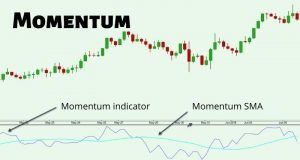A technical indicator is a formula that may be used to analyze price and volume data. It can also be used on a different technical indication.
The end result is a figure that may be used to forecast future price fluctuations.
The squiggly lines shown above, below, and on top of the price information on a chart are known as technical indicators.
Forex traders that follow technical analysis employ them.
A technical indicator provides a unique view on the intensity and direction of the underlying price movement.
Technical analysts utilize indicators to forecast future price changes by evaluating previous data.
A technical indicator can be used for three purposes:
- Traders will be notified if a certain condition is satisfied.
- Predict the price movement.
- Confirm the analysis that has been offered by current price movement or another technical signal.
Technical indicators are divided into two categories:
- Leading indications indicate when a trend is about to begin.
- The price activity is followed by lagging indicators.
Leading indicators attempt to anticipate price by calculating over a shorter time period than the price change. MACD, RSI, and Stochastic are the most common leading indicators.
These indicators generally function by determining if an item is “overbought” or “oversold.” When something is “oversold,” the presumption is that it will recover.
After a trend or reversal has begun, lagging indicators provide a signal. The Moving Average is the most frequent lagging indicator.
They don’t warn you about impending price changes; instead, they inform you how prices are moving (up or down) so you may trade accordingly.
Lagging indications cause you to buy and sell late, but they considerably lower your risk by putting you on the right side of the market in return for losing out on the early possibilities.
When trading in trending markets, you should use trailing indicators, and when trading in sideways markets, you should use leading indicators.
Technical Indicator Positioning on the Chart
There are two types of technical indicators in terms of where they should be put on a chart:
- Technical indicators with the same scale as prices are plotted on top of the prices on a chart as overlays. Moving averages and Bollinger Bands are two examples.
- Oscillators are technical indicators that are placed above or below a price chart and fluctuate between a local minimum and maximum. MACD, RSI, and Stochastic are some examples.
There are four different types of technical indicators.
Technical indicators are divided into four categories:
- Momentum
- Volatility
- Volume
- Trend-Following
Trend-Following Indicators
Traders can use trend following indicators to trade currency pairs that are going up or down.
These indications can help us determine the trend’s direction as well as whether or not a trend exists.
Trend-following indicators use some sort of price averaging to determine the direction and intensity of a trend.
Price is regarded to be in a bullish trend when it climbs above the average. A negative trend is indicated when price falls below the average.
Trend-following indicators include the following:
- Current trends, as well as support and resistance levels, are identified using moving averages.
- The MACD indicator is used to highlight changes in a trend’s strength, direction, velocity, and longevity.
- The parabolic SAR is used to identify possible price reversals.
Momentum Indicator

By comparing prices over time, momentum indicators aid in determining the rapidity of price fluctuations. It may also be used to figure out how much something weighs.
It’s computed by comparing current and prior closing prices.
This is usually represented by a line that oscillates as momentum changes beneath a price chart.
A divergence between price and a momentum indicator might indicate a shift in price direction in the future.
Examples of momentum indicators are as follows:
- Over a period of time, the stochastic illustrates the position of the closing price in relation to the high-low range.
- The CCI oscillator is a tool for detecting cyclical turns and trend reversals.
- RSI compares the up and down movements of a currency pair over a specific time period to determine its strength or weakness.
Indicators of Volatility

Volatility indicators assess the pace at which prices change in any direction.
This is usually determined by the difference between the highest and lowest historical prices.
They provide important information regarding the range of buying and selling that occurs in a given market, as well as assisting traders in determining when to shift direction.
Some examples of volatility indicators are as follows:
- Bollinger Bands are used to detect if prices are relatively high or low.
- The ATR (Average True Range) is a measure of volatility that takes into account any price gaps.
- The standard deviation is a statistical measure of market volatility that determines how far prices differ from the average.
Indicators of Volume

Volume indicators use some type of volume averaging (or smoothing) to determine the strength of a trend or validate a trading direction.
When volume grows, the biggest trends generally emerge.
The following are some examples of volume indicators:
- The volume-weighted average of accumulation and distribution during a specific period is measured by Chaikin Money Flow (CMF). The Chaikin Money Flow theory states that the closer the closing price is to the high, the greater accumulation has occurred.
- On Balance Volume (OBV) is a cumulative indicator that adds volume on up days and subtracts volume on down days to gauge purchasing and selling pressure.
- The Volume Oscillator (VO) shows the percentage difference between two moving averages of a security’s volume. It is based on the idea that the technical relevance of t is not the actual volume level, but the change in volume compared to the recent past.
How to Reduce the Number of False Signals
There is no such thing as a perfect technical indication.

A technical indicator is frequently paired with additional “tests” or indications to boost its reliability and reduce false signals, when the price movement departs from what was predicted from the indicator.
This is referred to as “confirmation” of the signal generated by the technical indicator.
The extra tests are referred to as “filters.”
The most frequent filters are divided into the following groups:
- The signal must be present for a certain period of time. A 50-day moving average, for example, must be above a 200-day moving average for at least three trading days.
- The signal’s magnitude must fall inside a certain range. An oscillator, for example, must be greater than 80% or less than 20%.
- When indications are based on a bigger volume, they are typically more significant.
Some indicators perform better across specific time periods, so selecting indicators that are appropriate for your trading horizon makes sense.
Another element to consider is the frequency of trading signals.
If you’re a day trader, you’ll want indicators that can create a large number of trading signals in a single day. Swing traders like fewer indications.
Fewer signals and cheaper trading expenses are generally the consequence of combining indicators with price action analysis.
Always keep in mind that technical indicators are simply that: indicators.
They do not ensure that a price will move in a specific direction.
When it comes to technical analysis, you typically don’t tell if a trend reversal is genuine or not until after it has occurred.
To give your views more context, it’s a good idea to look at charts with several time periods.

























